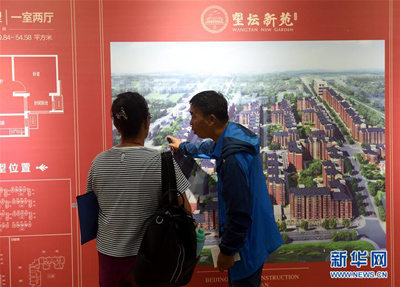By Tom McGregor, CCTV.com Panview commentator and editor
Editor's Note: CCTV.com Panview presents 'China Cares' — series of special coverage on China's rural reforms, charities and comprehensive efforts to help those in poverty unlock their potential for success.
China's efforts to alleviate poverty nationwide and to improve living standards for its population require bold moves to revitalize impoverished neighborhoods, commonly referred to as shantytowns. Accordingly, the Central Government has pledged substantial funding to renovate shantytowns.
The State Council, China's Cabinet, has introduced renewed calls to ensure all shantytown renovations are completed, which means building new homes for over 100 million Chinese by the end of 2020. The plans had already gone into action in 2016, while we can anticipate the main workloads to occur in 2018-2020.
Chinese Premier Li Keqiang has led State Council meetings to discuss the matter.
Capital city overhaul
Local officials in the capital city have played the most crucial roles to demolish shantytowns and provide better housing for impoverished residents. Beijing represents the heart and soul of the nation, so you can expect to witness sweeping renovations to happen here.
As of the end of September 2017, Beijing has surpassed its annual target number of homes, investments and people involved in shantytown renovations, which resulted in helping 235,000 Beijingers.
Beijing's population is believed to be at around 23 million and the city is struggling with over-crowded conditions. Local officials hope to rebuild Beijing for a better tomorrow.
Measures will include: Relocating residents from shantytowns and moving them into new homes, building more infrastructure such as roads, schools and hospitals, while improving the environment and public safety.
Meeting specific targets
The local government has achieved remarkable success by highlighting detailed plans and goals. So far for the term - January to September 2017 - 40,718 new homes were built for families from shantytowns, surpassing its 40,000 annual target.
All 16 districts in Beijing are required to engage in the project, according to the headquarters of Beijing Major Projects Construction. A total investment of RMB80.8bn (US$12.27bn) has been poured into it, which has already surpassed the annual target - RMB75bn. and more than double compared to 2015.

(Residents of Wangtan shantytown renovation project of Dongcheng District,Beijing are selecting their new flats on Sept. 4, 2017. Photo from Xinhua by Luo Xiaoguang)
As reported by China.org, 11 districts including Dongcheng, Chaoyang and Fengtai, have not only fulfilled tasks but are ahead of schedule. Fengtai, southern Beijing, is transforming its shantytown image and enjoying more prosperous times.
Beijing's shantytown renovation are setting the benchmark as the rest of the country has embarked in similar projects to offer new homes for the poor.
Securing millions of homes
According to China Daily, the country is expected to witness full-delivery of 18 million new homes that have been built in the past three years. Supporters say shantytown renovations can enhance supply-side structural reforms and improve overall living standards.
"Our institutional advantages have been demonstrated over the past eight years as the campaign has achieved fruitful outcomes and a set of good practices," Premier Li is quoted as saying when presiding over a State Council executive meeting in May 2017.
Li added, "We want the families to move into their new homes to enjoy their new lives as early as possible."
China's Ministry of Housing and Urban-Rural Development has invested RMB1.48 trillion (US$215.25bn) in the nationwide project, while also providing monetary compensation for families relocating.
The economic benefits are likely to include more investment and consumption in urban areas.
Overcoming key challenges
Completing shantytown renovations will be no easy task, since it requires huge sums of money and coordination with local governments, construction firms and banks to maintain smooth operations.
Beijing has selected two finance channels - China Development Bank and Agriculture Development Bank - to provide loans and monetary assistance in the all-encompassing project.
The Central Government has implemented tight deadlines for demolishing shantytowns and constructing new homes, while enforcing strict quality controls, so new homes have adequate electricity, water, plumbing and installation to keep residents safe and comfortable, which are a necessity.
"China's industrialization and urbanization is a lasting effort," said Premier Li. "We have many people that are yet to move to the cities and start new lives. We should remain unrelenting in our efforts to live up to the people's expectations."
Grassroots approach
In military circles, there's a saying that you are only as strong as your weakest link, meaning that rivals can defeat you when your weakness is exposed and not adequately defended.
Many global citizens have witnessed the amazing economic and diplomatic rise of China and impressed with China's transformation from Third World status a few decades to emerge as the world's second largest economy in recent years.
Nevertheless, tens of millions of Chinese continue to live in shantytowns, which seems to contradict our understanding of the country's glorious economic miracle.
But Beijing has moved ahead on a strategy to provide new homes for 100 million Chinese that are still facing poverty and for those less fortunate, they hope the project becomes a resounding success.
(The opinions expressed here do not necessarily reflect the opinions of Panview or CCTV.com. )

Panview offers a new window of understanding the world as well as China through the views, opinions, and analysis of experts. We also welcome outside submissions, so feel free to send in your own editorials to "globalopinion@vip.cntv.cn" for consideration.
















